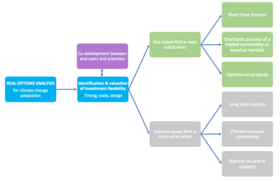The added value of real options analysis for climate change adaptation
SEASCApe-II is all about compound risks and flexible adaptation strategies at the Baltic Sea coast. For us, this means that things are getting much more complex than in phase I of the SEASCApe project, where life was relatively easy with simpler statistics and adaptive decision-making in a footnote.
Combining these additional dimensions for local case studies will be challenging. As we have to wait for each other’s outputs, some work in the individual work packages has to be performed first till we can get to the most exciting part of integrating hazard, impacts and flexible adaptation strategies. The economic valuation approaches for the latter are diverse and heavily debated. WIREs Climate Change has picked up on this debate, and presents a little opinion battle on the use of these so-called real options analysis (ROA) methods. It contrasts two opinion articles in the Early View section, one arguing against and one arguing in favour of the use of ROA methods. Given the work to be done in Seascape II, I clearly did not mind to join the latter provided that one does not start from a model and fits the adaptation decision and context to it, rather than vice versa:

